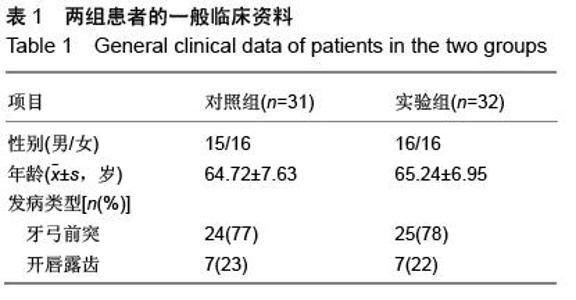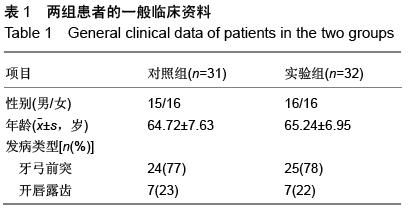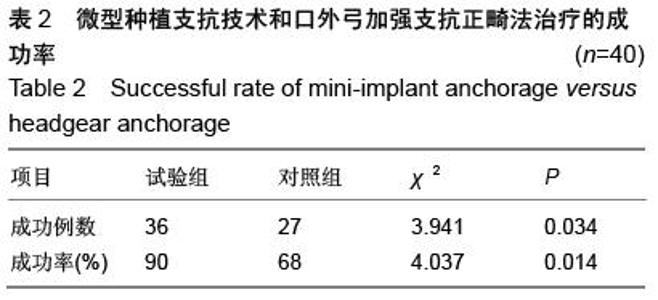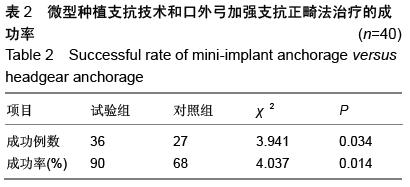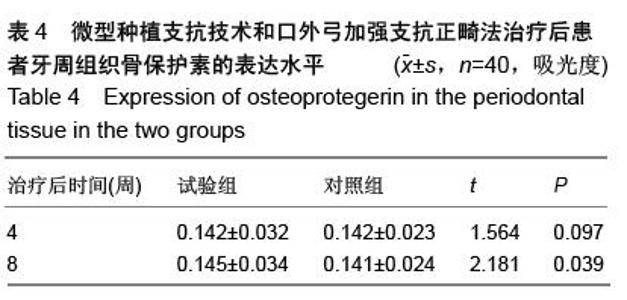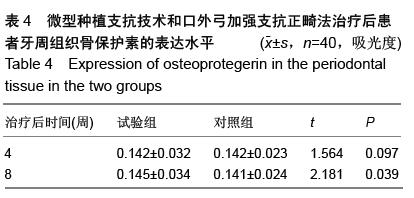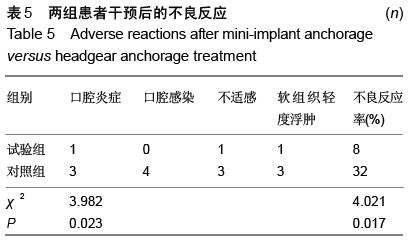| [1] 李勤,苏怡.微型种植体支抗负载对邻近牙根及牙周组织的影响[J].中国组织工程研究,2014,38(18):6085-6089.
[2] 宋姿霖.分析微型种植体支抗在口腔正畸中的应用价值[J].全科口腔医学,2014,1(5):3-4.
[3] 李联钦.微型种植体支抗在口腔正畸临床中的应用[J].中国社区医师,2011,13(30):45.
[4] 王晓华,何春秀.微型种植体支抗在口腔正畸治疗中的应用效果[J].中国医学工程,2014,22(1):86.
[5] 吴金海.微型种植体支抗在口腔正畸治疗中的临床效果分析[J].中国医学工程,2013,21(1):52.
[6] 裴壮敏.微型种植体支抗在口腔正畸治疗中的应用价值[J].当代医学,2013,19(14):3-4.
[7] 安葵,万惠子,肖长芬.微型种植体支抗在口腔正畸治疗中的疗效评价[J].实用临床医药杂志,2013,17(13):71-72.
[8] 倪志锋.微型种植体支抗在口腔正畸中的临床应用[J].吉林医学,2009,30(11):1000-1001.
[9] 唐弘夫.微型种植体支抗在口腔正畸中的临床应用与效果观察74例[J].中国医药指南,2010,8(17):41-42.
[10] 姚远.微型种植体支抗在口腔正畸中的应用[J].海南医学院学报,2011,17(11):1544-1546.
[11] 陈辉,刘泓虎.微型种植体支抗在口腔正畸中的应用进展[J].上海交通大学学报,2014,34(11):1700-1704.
[12] 褚伟东,潘晓岗,段松海,等.正畸治疗安氏Ⅲ类错(牙合)伴下颌偏斜临床分析[J].中国基层医药,2012,3(8): 2652-2653.
[13] Serra G, Morais LS, Elias CN, et al. Sequential bone healing of immediately loaded mini-implants: histomorphometric and fluorescence analysis. Am J Orthod Dentofacial Orthop. 2010;137(1):80-90.
[14] 冯毅.微型种植体支抗在青少年口腔正畸治疗中的应用[J].河北医药,2013,35(3):352-353.
[15] 蒳荷芽.口腔正畸治疗中微型种植体支抗的应用价值评析[J].全科口腔医学杂志,2015,2(4):41-42.
[16] Luzi C, Verna C, Melsen B. Immediate loading of orthodontic mini-implants: a histomorphometric evaluation of tissue reaction. Eur J Orthod. 2009; 31(1):21-29.
[17] Janssen KI, Raghoebar GM, Vissink A, et al. Skeletal anchorage in orthodontics--a review of various systems in animal and human studies. Int J Oral Maxillofac Implants. 2008;23(1):75-88.
[18] Cornelis MA, Scheffler NR, De Clerck HJ, et al. Systematic review of the experimental use of temporary skeletal anchorage devices in orthodontics. Am J Orthod Dentofacial Orthop. 2007;131(4 Suppl):S52-58.
[19] Torcasio A, van Lenthe GH, Van Oosterwyck H. The importance of loading frequency, rate and vibration for enhancing bone adaptation and implant osseointegration. Eur Cell Mater. 2008;16:56-68.
[20] Gritsch K, Laroche N, Morgon L, et al. A systematic review of methods for tissue analysis in animal studies on orthodontic mini-implants. Orthod Craniofac Res. 2012;15(3):135-147.
[21] Hoste S, Vercruyssen M, Quirynen M, et al. Risk factors and indications of orthodontic temporary anchorage devices: a literature review. Aust Orthod J. 2008;24(2):140-148.
[22] 王冉.微型种植体支抗在成人口腔正畸中的应用[J].检验医学与临床,2014,(15):2151-2152.
[23] 王海燕.微型种植体支抗在口腔正畸治疗中的应用价值[J].河南医学研究,2015,24(5):46-47.
[24] 田雪梅.微型种植体支抗在口腔正畸治疗中的应用效果[J].中外医学研究,2015,13(11):127-128.
[25] Ireland AJ, Soro V, Sprague SV, et al. The effects of different orthodontic appliances upon microbial communities. Orthod Craniofac Res. 2014;17(2): 115-123.
[26] Freitas AO, Marquezan M, Nojima Mda C, et al. The influence of orthodontic fixed appliances on the oral microbiota: a systematic review. Dental Press J Orthod. 2014;19(2):46-55.
[27] Kuboniwa M, Tribble GD, Hendrickson EL, et al. Insights into the virulence of oral biofilms: discoveries from proteomics. Expert Rev Proteomics. 2012;9(3): 311-323.
[28] Ghijselings E, Coucke W, Verdonck A, et al. Long-term changes in microbiology and clinical periodontal variables after completion of fixed orthodontic appliances. Orthod Craniofac Res. 2014;17(1):49-59.
[29] Yáñez-Vico RM, Iglesias-Linares A, Ballesta-Mudarra S, et al. Short-term effect of removal of fixed orthodontic appliances on gingival health and subgingival microbiota: a prospective cohort study. Acta Odontol Scand. 2015;73(7):496-502.
[30] Baka ZM, Basciftci FA, Arslan U. Effects of 2 bracket and ligation types on plaque retention: a quantitative microbiologic analysis with real-time polymerase chain reaction. Am J Orthod Dentofacial Orthop. 2013;144(2): 260-267.
[31] van Gastel J, Quirynen M, Teughels W, et al. Longitudinal changes in microbiology and clinical periodontal parameters after removal of fixed orthodontic appliances. Eur J Orthod. 2011;33(1): 15-21.
[32] van Gastel J, Quirynen M, Teughels W, et al. Longitudinal changes in microbiology and clinical periodontal variables after placement of fixed orthodontic appliances. J Periodontol. 2008;79(11): 2078-2086.
[33] Amasyali M, Enhos S, Uysal T, et al. Effect of a self-etching adhesive containing an antibacterial monomer on clinical periodontal parameters and subgingival microbiologic composition in orthodontic patients. Am J Orthod Dentofacial Orthop. 2011;140(4): e147-153.
[34] Ristic M, Vlahovic Svabic M, Sasic M, et al. Clinical and microbiological effects of fixed orthodontic appliances on periodontal tissues in adolescents. Orthod Craniofac Res. 2007;10(4):187-195.
[35] van Gastel J, Teughels W, Quirynen M, et al. Longitudinal changes in gingival crevicular fluid after placement of fixed orthodontic appliances. Am J Orthod Dentofacial Orthop. 2011;139(6):735-744.
[36] Pejda S, Varga ML, Milosevic SA, et al. Clinical and microbiological parameters in patients with self-ligating and conventional brackets during early phase of orthodontic treatment. Angle Orthod. 2013;83(1): 133-139.
[37] 孙玉刚,田红,陈超.重度深覆(牙合)正畸中微型种植体支抗系统的应用观察[J].山东医药,2012,52(22):78-79.
[38] 陈震春.口腔正畸治疗中微型种植体支抗的使用价值[J].医药论坛杂志,2011,32(24):48-50.
[39] 冯毅.微型种植体支抗在青少年口腔正畸治疗中的应用[J].河北医药,2013,35(3):352.
[40] 肖永芳,徐宝华,刘静明.微型种植体支抗治疗成人骨性Ⅱ类错(牙合)畸形患者的研究[J].中国美容医学,2012,21(7): 1207-1209. |
